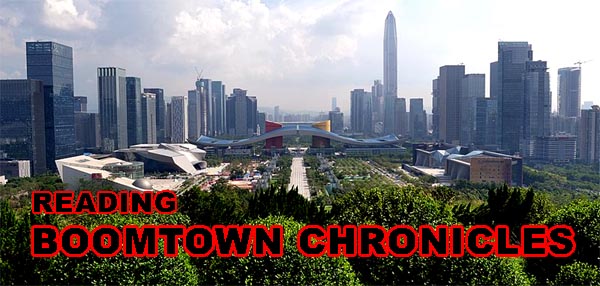 |
| Shenzhen, the Boomtown (Wikipedia) |
Note: Between Lesson #01-128 and #01-208, I wrote 72 lessons explaining expressions in articles published in the Shenzhen Daily. Read more about "Reading Boomtown Chronicles."
Get Ready: Does your country, state/province, or region have a "mother river"? What is it?
Boomtown Chronicles Part XXI - published Monday, November 17, 2008
- Title: "Mother river regaining faded beauty"
mother river: the main river, one which may have one or more tributaries (see below). As such, it usually has a single name from its source to its mouth.
I can only assume that this is the English form of a common Chinese expression. If you run a search on "mother river" in quotes, you'll find that almost every response is about a river in China: usually the Yellow or the Yangtze, but also some more local "mother rivers" as well.
source: where a river starts. It may be a spring or a lake, or it may just be an area where the melting of ice or snow, or the gathering of rainwater, joins to create the river. The area from which such water gathers may be called a "catchment" or "watershed." The Shenzhen River's source is given in the a link as Wutongshan Mountain.
mouth: where a river empties into a lake or sea. The proper mouth of the Shenzhen River is at Shenzhen Bay, near the free Trade Zone in Futian.
tributary: a lesser river that "feeds" a main river. (Tributaries may also run into lakes or seas and "feed" them.) The word comes from "tribute," which in turn comes from a Latin word meaning "to pay." So these smaller rivers "pay water into" the Mother River.
A link gives a list of the Shenzhen River's tributaries: the Ping Yuen, Shek Sheung, Sheung Yue and Ng Tung rivers flow into the Shenzhen from the Hong Kong side, and the Buji, Shawan, Futian, and Huanggang rivers feed it from the mainland.
--------
We are told that the Shenzhen River is also known as the Sham Chun River, and that the other border river between Shenzhen and Hong Kong, the Shatoujiao River, is also called the Sha Tau Kok River.
In both cases, the second name is the Cantonese reading of the same Chinese characters which are pronounced Shenzhen and Shatoujiao in Mandarin. Non-Chinese may find this confusing. But in fact, Shenzhen is in Guangdong Province, which historically spoke Cantonese, the dialect found in Hong Kong and Guangzhou. Local people will sometimes pronounce the name of the city Sham Chun. The (nowadays) better-known name Shenzhen only became widespread after the opening reforms, when there was an influx of non-Cantonese speakers into the area.
More about the "Mother River" in Lesson #01-188.
--------
Read more: https://en.wikipedia.org/wiki/Shenzhen
Practice: Choose the correct term to fill in the blank in the sentence below:
- Cantonese
- Mandarin
- mother river
- mouth
- source
- tributary
- Despite the river's importance to the Egyptians, the ________ of the Nile wasn't discovered until 1858--by an Englishman.
- ________ is the standard dialect of the Chinese language.
- The Missouri is the second longest river in America, and a ________ of the longest: the Mississippi.
- New Orleans is located near the Gulf of Mexico and the ________ of the Mississippi River.
- ________ is the dialect generally spoken in southern China, centering on Guangdong Province.
- Many countries have a "________," including the Nile in Egypt, the Yellow River in China, and the Mississippi in America.
Answers are in the first comment below.
Submitted to the Shenzhen Daily for November 24, 2008


Answers to the Practice: 1. e; 2. b; 3. f; 4. d; 5. a; 6. c
ReplyDelete